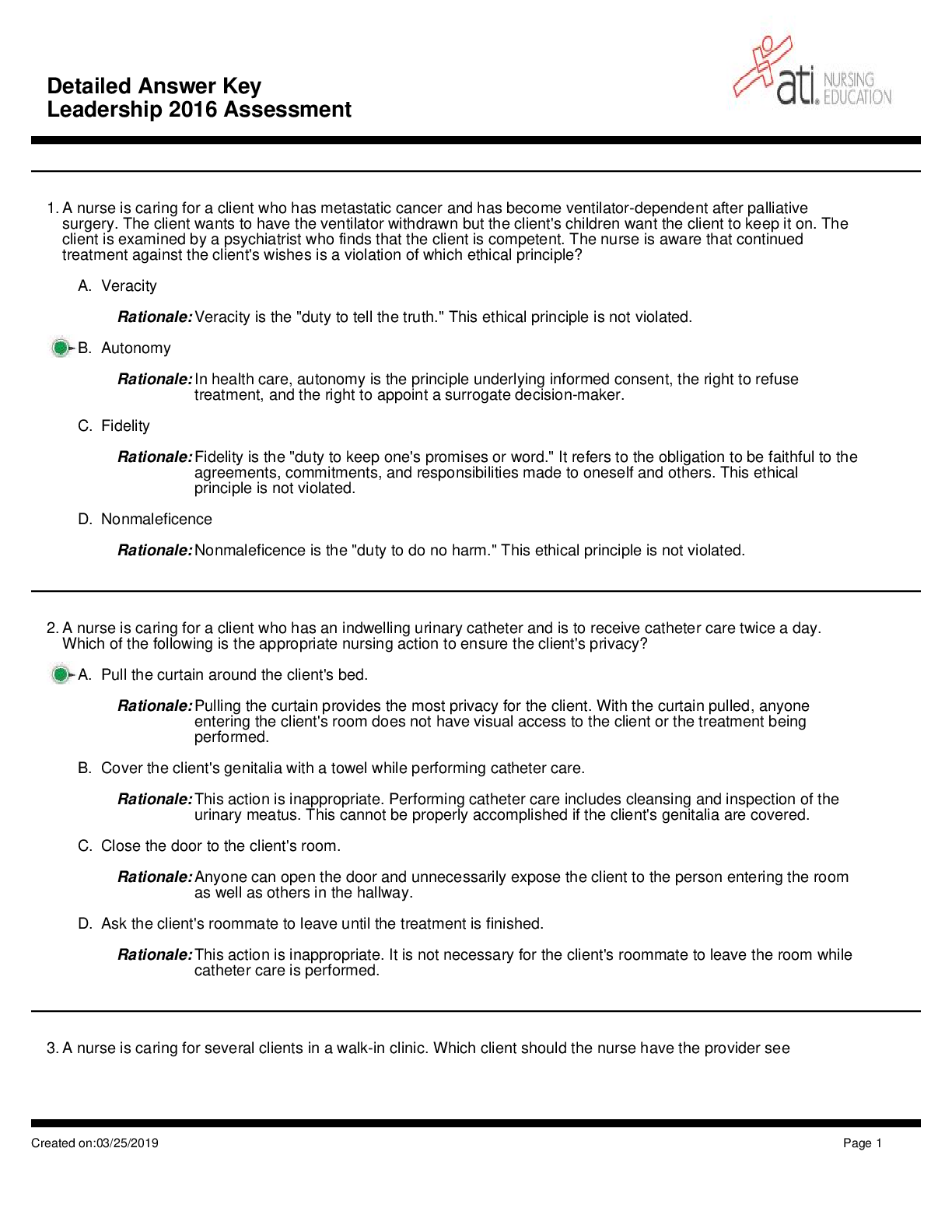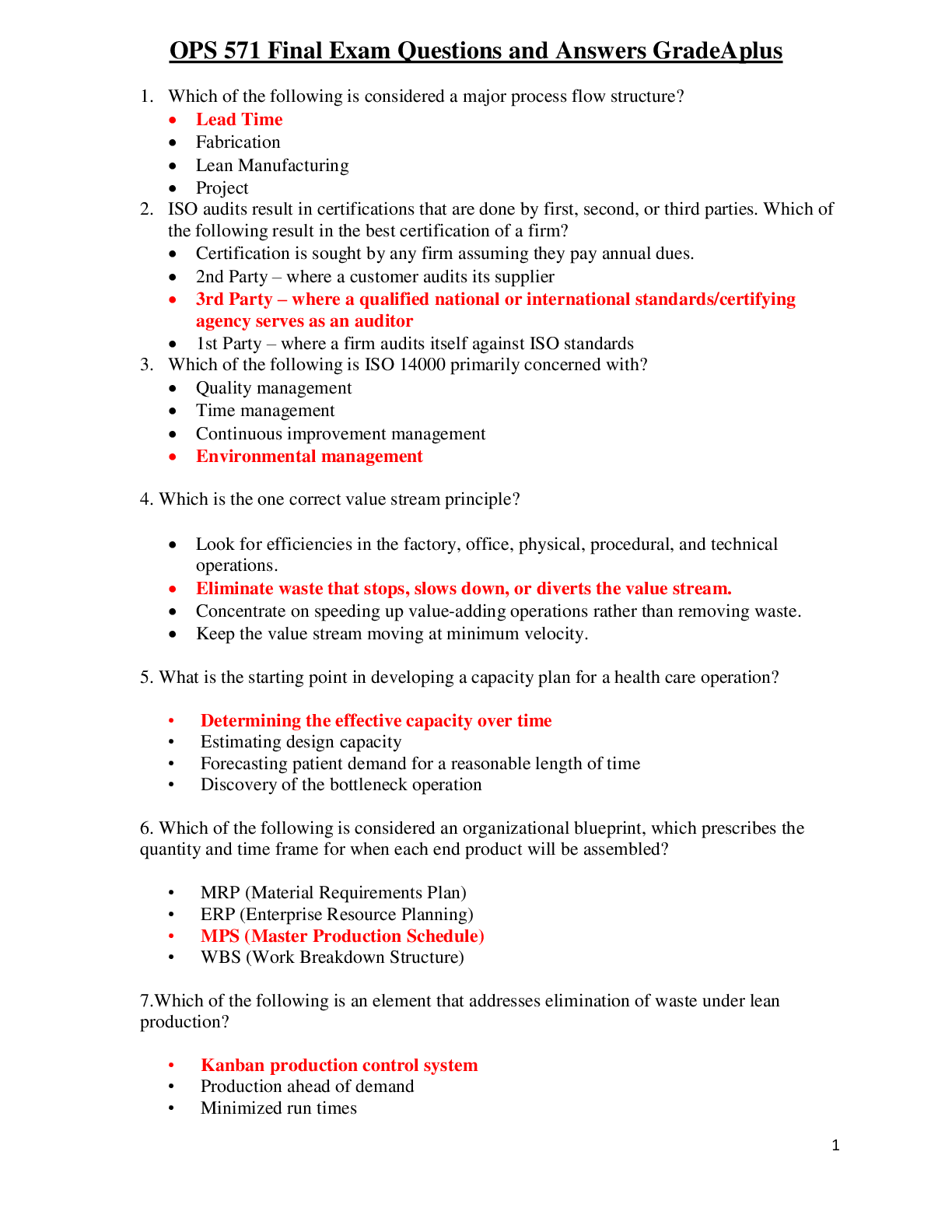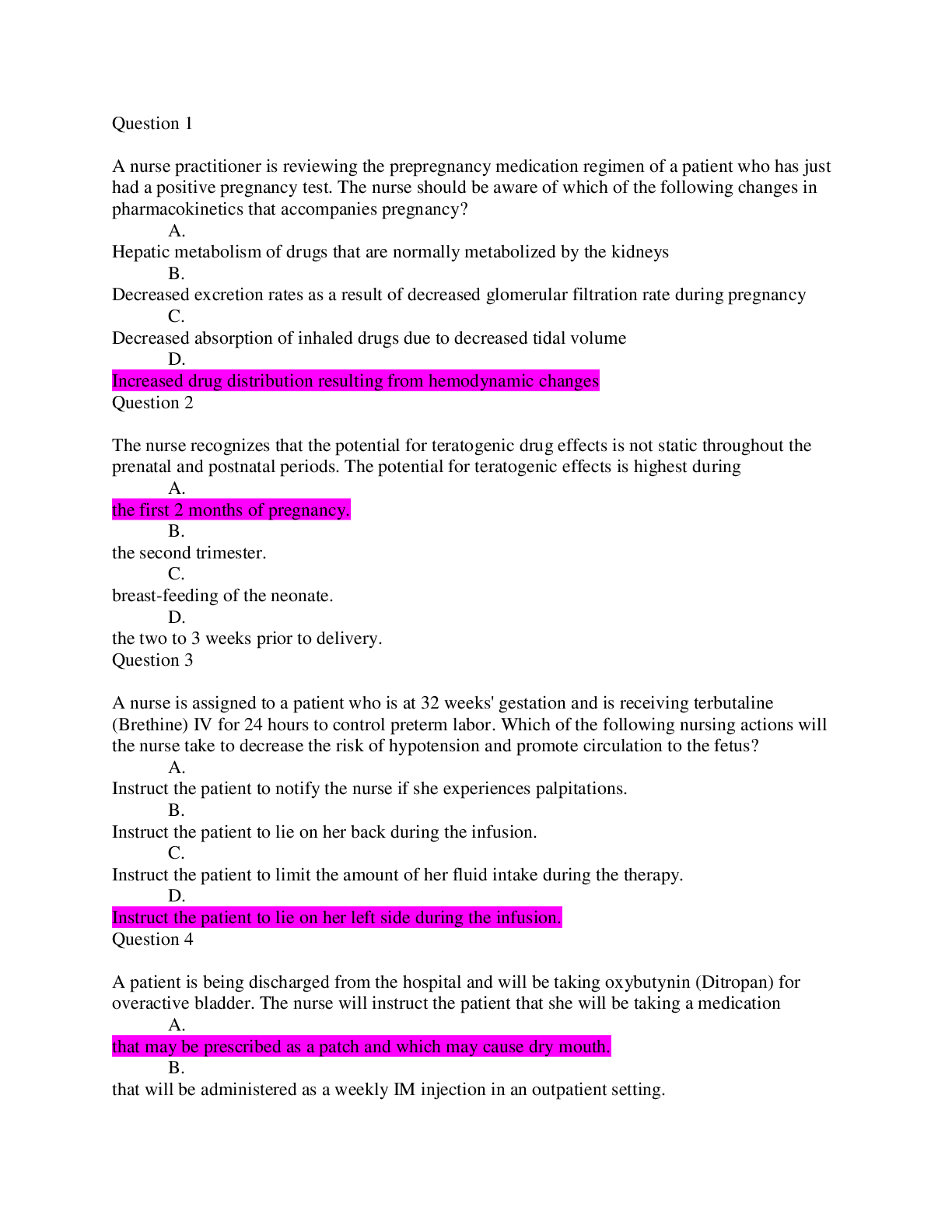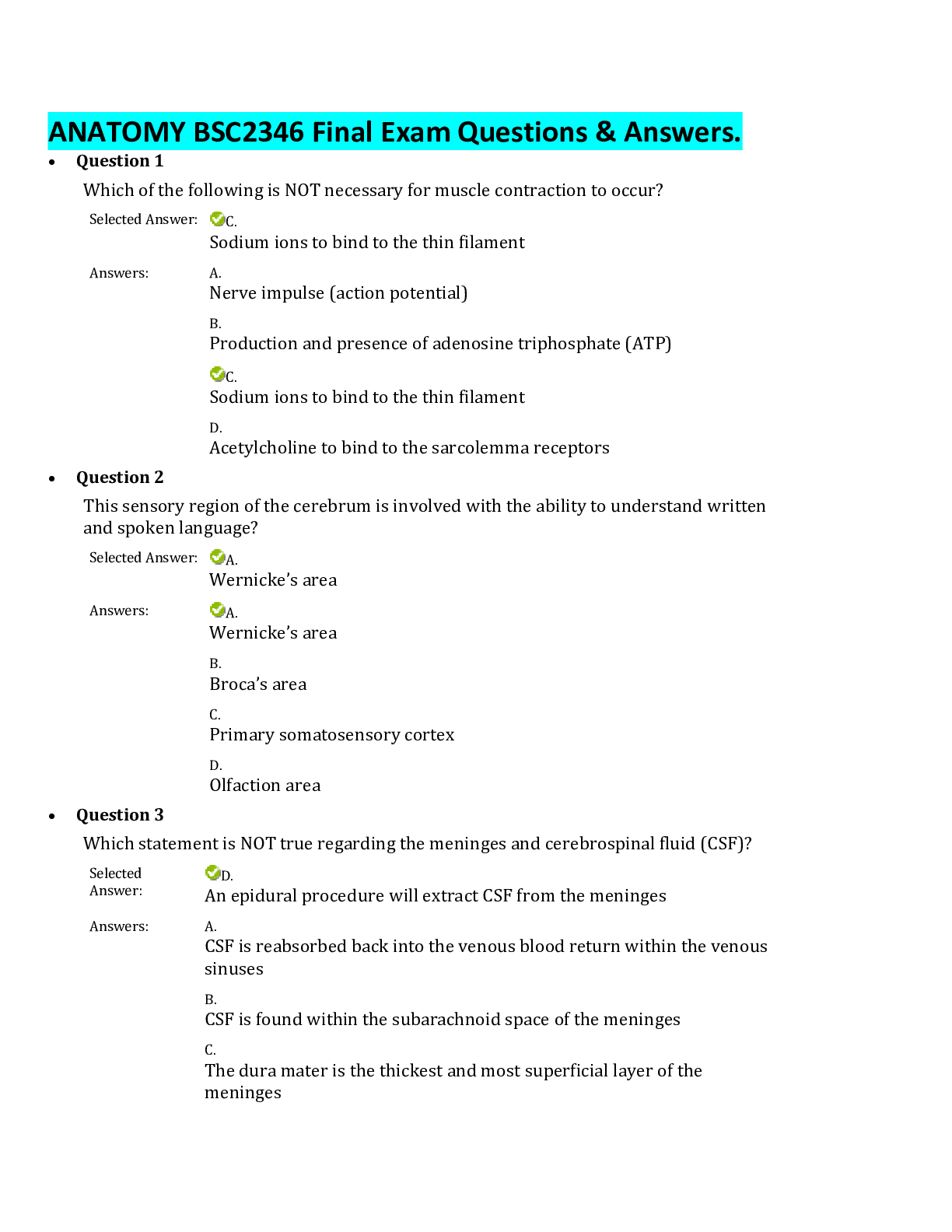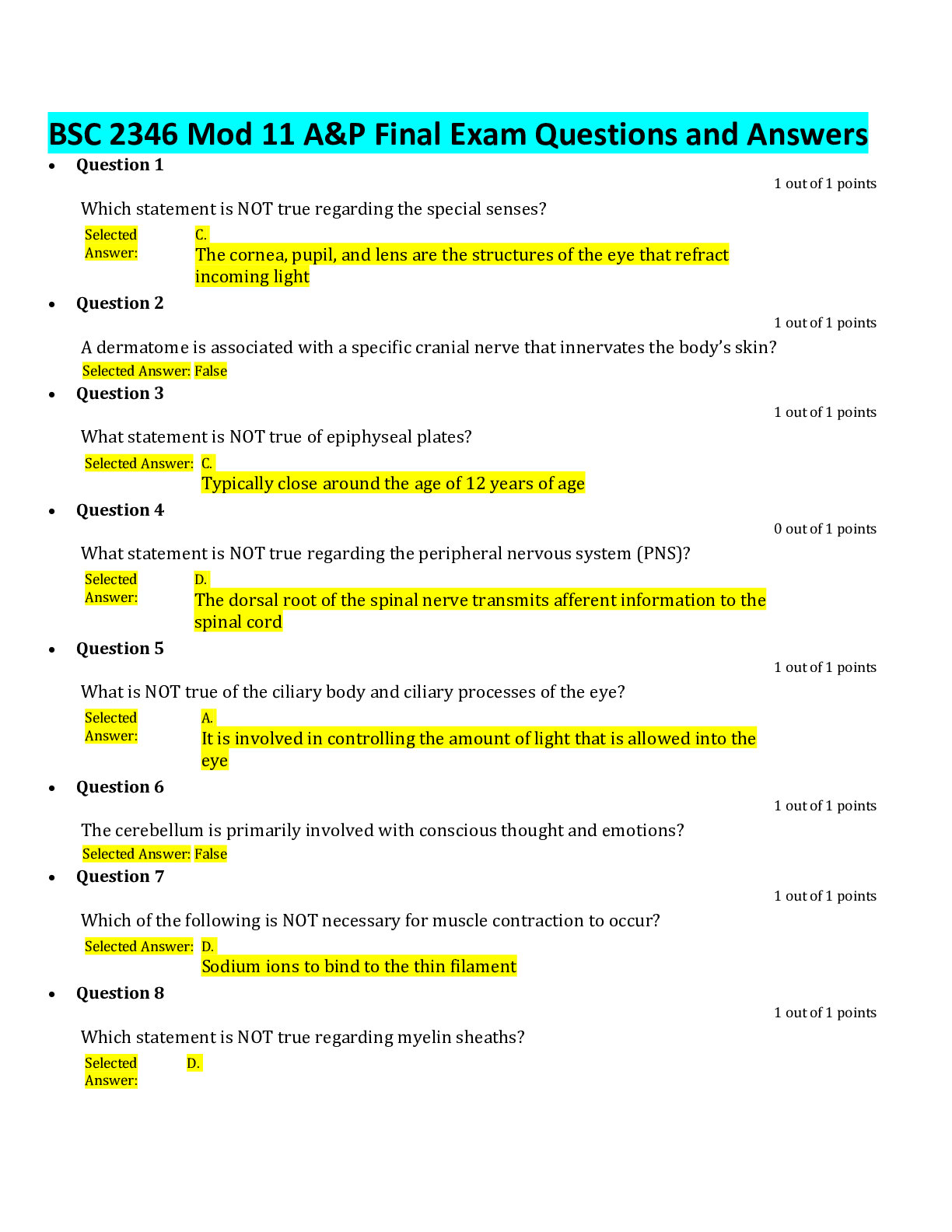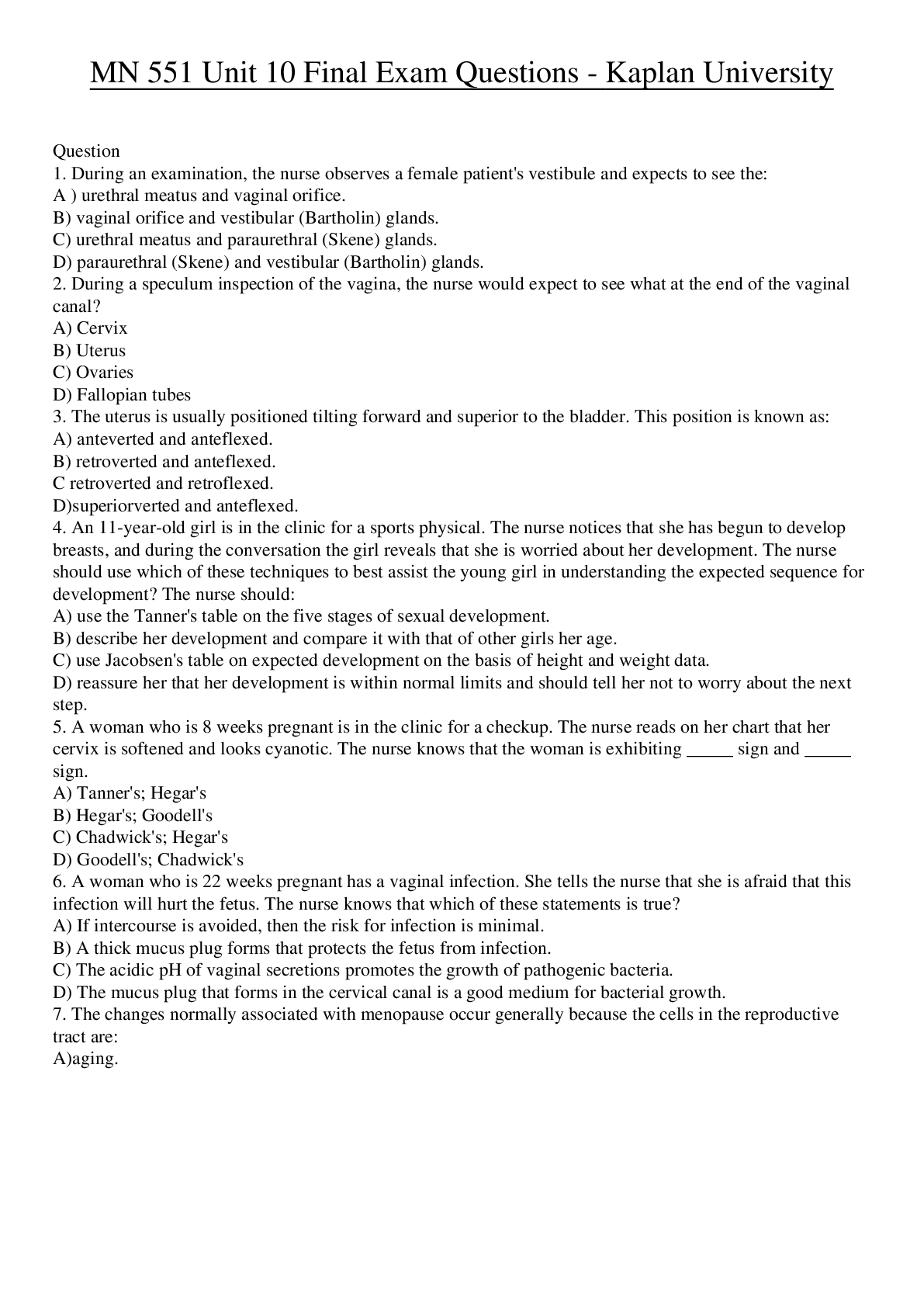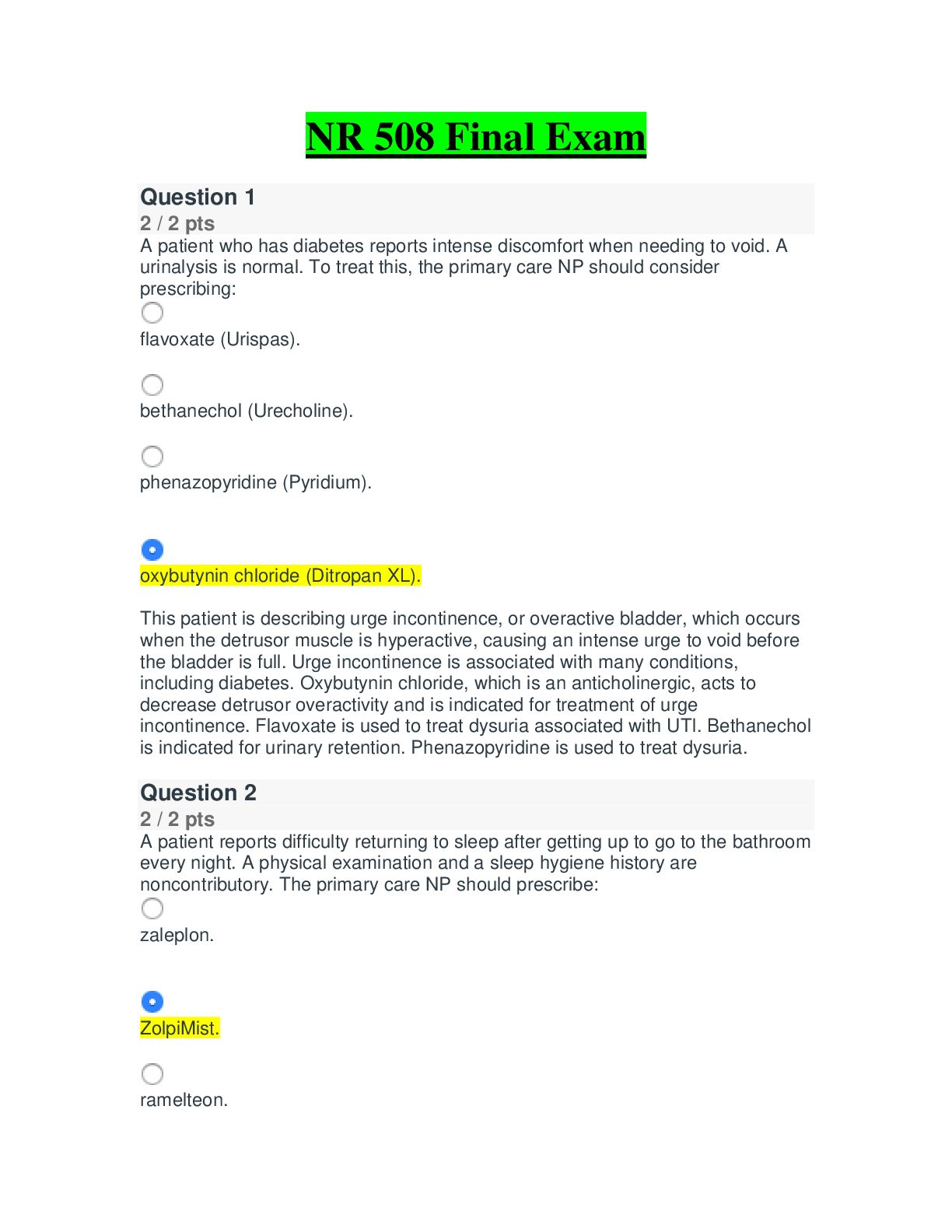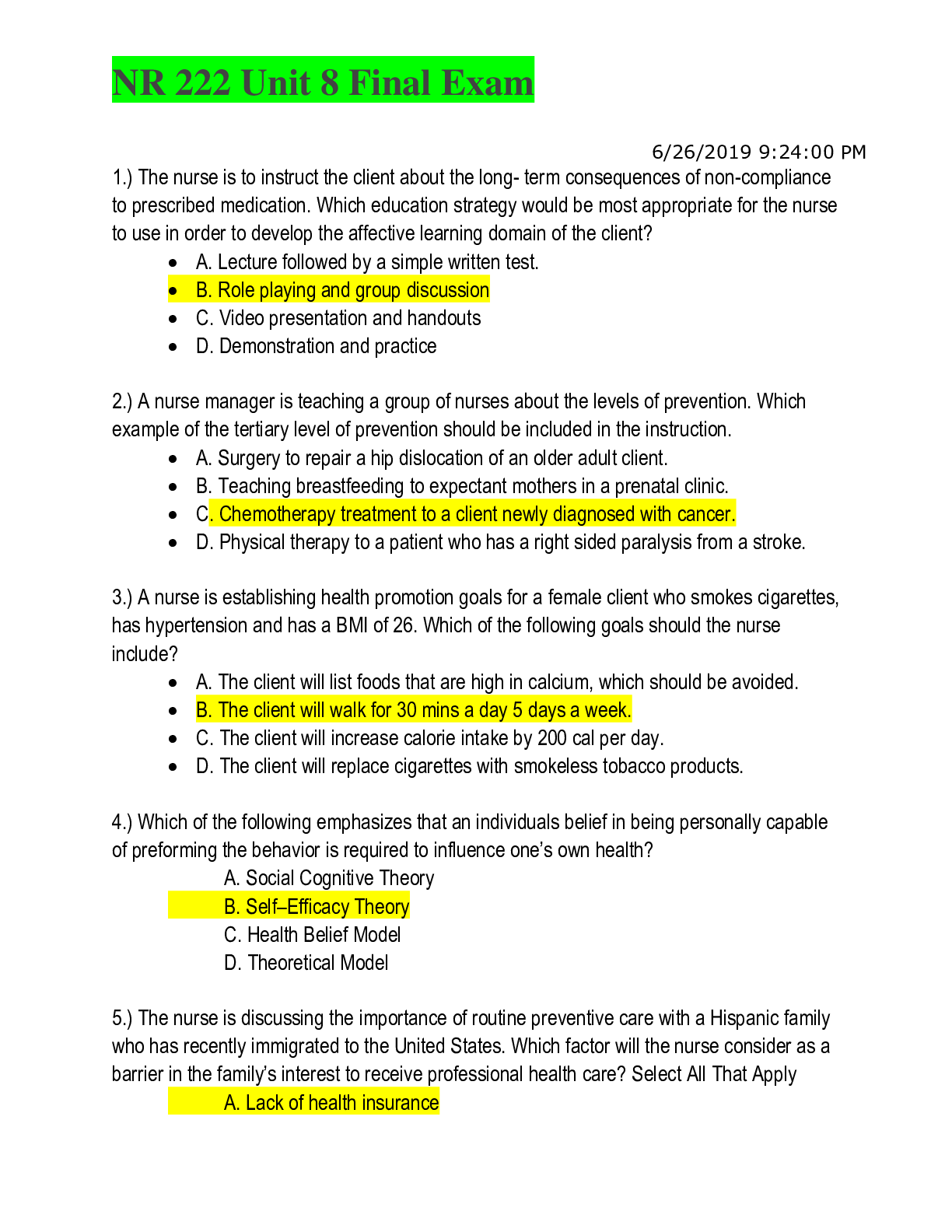Psychology > EXAM > PSY 550 Final Exam questions and answers,100% CORRECT (All)
PSY 550 Final Exam questions and answers,100% CORRECT
Document Content and Description Below
Danielle Ferraro Short Answers The 20 questions below are worth 4 points each. 1. A school psychologist strongly believes a particular child is in need of special services. What is the psychologis... t trying to control for if he or she uses the most recently normed test available? a. The school psychologist is trying to help the child with their potential learning disabilities. The psychologist is trying to help the child develop a plan to make sure that the child receives the best education possible, also to figure out how to appropriately teach the student. In other words they are trying to develop a proper educational program or curriculum in order to ensure the best and most effective educational process for the child. 2. What are two benefits of the WASI? a. The WASI is used to determine if further in-depth intellectual assessments need to be completed. It also helps to reassess after a comprehension evaluation. In addition it aids in estimating in a full scale IQ score while also assessing cognitive functioning individuals who were referred for a psychiatric evaluation. 3. Identify three improvements of the WAIS-IV over the WAIS-III. a. Improvements were made when the WAIS-IV came out. They include the following. The WAIS-IV offers more precision and simplicity. This tests is a comprehensive battery test that enhanced the utility. With these improvements the hallmark of the Wechsler tradition is intact and has a rigorous collection and stratification of normative data. In top of this they developed a better test to help with the ever changing demographics, emerging research, the clinical needs and the increasing caseloads. 4. Provide one advantage and one disadvantage of group-administered intelligence tests. a. Group administered tests have a broader application than individual tests. The scoring format however for most group administered tests are multiple choice, which is less flexible and therefore yields much less diagnostic information. 5. Give three examples of extra-test behavior on an ability test. a. Due to the fact that more and more adults required cognitive testing, the WAIS-IV was Extra-test behaviors are observations during testing that relate to the performance of an individual. These can include skipping questions, loss of focus, and fidgeting. 6. Name three recommended usesfor the Woodcock-Johnson III. a. The Woodcock-Johnson III is often recommended when the researcher would like to assess and contrast the performance of an individual in a variety of conditions and then draw conclusions about relative strengths and weaknesses of the individual. By revealing the strengths and weaknesses of an individual and then comparing them can reveal individual differences in information processing that may be important to consider when determining the nature of a learning problem or disability. Also the Woodcock-Johnson III provides a detailed understanding of one’s ability and how to facilitate the development of targeted interventions. 7. Name three things that would be included in the best approach to diagnosing a specific learning ability. a. There are some criteria which must be met for proper diagnosis. The student must demonstrate a severe discrepancy between perceived potential and actual achievement as measured by formal and informal assessments. The student’s learning disability may not result primarily from visual or hearing impairment, mental retardation, serious emotional disturbance, or cultural differences. The student manifests a demonstrated need for special education services. Without specialized support, the student’s disability will prevent him or her from learning. 8. What is the purpose of empirical criterion keying? a. The purpose of empirical criterion keying is that it emphasizes the selection of items that discriminate between normal individuals and members of different diagnostic groups. This is done regardless of whether the items appear theoretically relevant to the diagnoses of interest. 9. Identify two functions of validity scales on personality tests. a. Validity scales aid in detecting attempts by patients to present themselves in a favorable light, and to detect attempts at fulfilling self-gratifying prophecies. Basically, the scale is there to help get accurate results and throw out the high scores of people who potentially were just answering the questions to get a high score and not actually answering the questions based on their personality, it also does that for the lower scales. 10. Identify a criticism of the MMPI that contributed to the need for developing the MMPI-2.Identify a criticism of the MMPI-2.What is the purpose of the inquiry stage of the administration of the Rorschach test? a. The MMPI received criticism because the scales themselves were not theoretical by way of using the participants’ clinical diagnoses to determine the scales’ content. This is why the MMPI-2 was developed. The scales were created based on a group with known psychopathologies. 11. What is the purpose of the inquiry stage of the administration of the Rorschach test? a. The main purpose of the inquiry stage is to acquire any further information on the subject’s responses. So, as to be used for scoring the record that is after associations have been acquired for all the ten cards. 12. Identify three criticisms of projective tests. a. The criticisms of projective tests are as follows; there have been questions surrounding the accuracy and validity of the measure. Second researchers have critiqued that they have poor diagnostic measures. Thirdly, they have been criticized for measuring connections regarding the most recent experiences of an individual rather than the deepest subconscious desires. 13. What principle do assessors utilize when interpreting the TAT? a. The TAT is a projective instrument that asks subjects to project their habitual patterns of thought and emotion onto the pictures shown to them. Psychologists do not refer to this as a test because there are no true right or wrong answers. It is better known as a technique. 14. Give an example of a behavioral assessment approach. a. An examples of a behavioral assessment approach is a functional behavioral assessment or also known as a FBA. 15. What does a mental status exam assess? a. A mental status exam assesses the client’s behavior and cognitive ability. It also looks at the client’s presentation and begins to conceptualize their functioning into a formal diagnosis. 16. Give an example of the Barnum effect. a. The Barnum effect in regards to psychology refers to people being gullible while reading descriptions of themselves and their behavior. In other words they believe what other people say about them without proper evidence. It is like when someone goes and gets a psychic reading, you may believe everything they say is going to happen will, but there is no real proof that it is going to. When the events do come true it strengthens the belief. 17. Why is it recommended to utilize the BDI-II with other tests? The BDI-II is a self-analysis report it has clear and precise wording and also includes information on sleep and diet. Though it provides a lot of information it should be used with other tests to provide a more rounded look at the person and also to ensure that the answers the client provided are accurate and can be duplicated using other tests. 18. What are three things that the Tower of Hanoi measures> a. The Tower of Hanoi puzzle assesses a set of cognitive abilities called executive functions. Problem solving abilities are exhibited. This can differentiate groups based on performance. 19. Give an example of a performance assessment. a. Performance assessments are assignments given to students that break the cycle of traditional testing. They can include group projects and written assessments that gauge creativity and individual expression. 20. What is an assessment center and what is it utilized for? a. An assessment center is a technique used in selecting candidates for a job or organization. Assessments involve traditional tests such as interviews, psychological evaluations, and simulation exercises. Essay Questions The essay questions below are worth 10 points each. 1. Compare and contrast two established personality assessments discussed in the course.Include in your discussion strengths and limitations of each measure. a. Personality assessments attempt to measure your basic personality style and are most used in research or forensic settings to help with clinical diagnoses. Two of the most well-known personality tests that were discussed in this course are the MMPI and the Rorschach Inkblot Test. The MMPI is composed of several hundred “yes” or “no” questions and the Rorschach is comprised of a lot of cards that contain inkblots. Both of these tests are designed to test responses and based on these responses, we can determine any abnormalities in personality which may need to be further addressed. Both of these tests are subjective, so reliability and validity are severely threatened. 2. Throughout the course, issues related to cultural diversity have been addressed.Identify one intelligence, educational, or personality measure and describe its strengths and weaknesses as it relates to diversity. a. The National Council for Accreditation of Teacher Education (NCATE) now defines diversity as differences among groups of people and individuals based on ethnicity, race, socioeconomic status, gender, exceptionalities, language, religion, sexual orientation, and geographical area. Thus, teach¬ers must be prepared to identify diverse students’ strengths, weaknesses, aspirations, limi¬tations, and special needs. Today’s classrooms must celebrate diversity. One subject that may require added attention in terms of cultural diversity is language arts. There are many remedial students in the US who have emigrated from Spanish-speaking countries that are not familiar with the English language. However, they may be very skilled in the sciences or mathematics. 3. Identify and describe at least three ethical dilemmas or responsibilities a psychological assessor may face. a. One ethical dilemma that a psychological assessor may encounter is the problem of bias. They must not communicate in favor towards the client even though empathy is required for an effective session. Professionals in the field need to keep a distance so that they can adequately and reliably assess the individual without any externalities interfering. Another ethical implication here is the client’s reluctance to be honest with what he or she is feeling. This may generate some frustration with the assessor and may also skew results dramatically. Lastly, religious complications may arise with the client. The client may or may not wish to divulge certain information due to his or her belief system, which is something that the assessor must conform to in order to uphold their reputation and position. [Show More]
Last updated: 1 year ago
Preview 1 out of 3 pages
Instant download

Buy this document to get the full access instantly
Instant Download Access after purchase
Add to cartInstant download
Reviews( 0 )
Document information
Connected school, study & course
About the document
Uploaded On
Feb 06, 2021
Number of pages
3
Written in
Additional information
This document has been written for:
Uploaded
Feb 06, 2021
Downloads
0
Views
36













